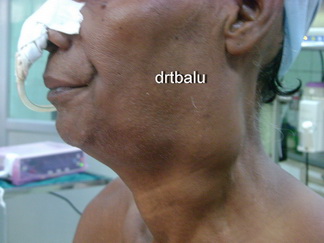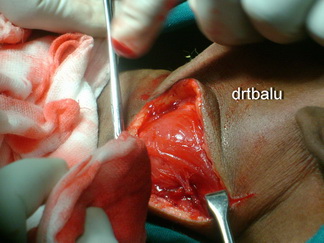Mucoepidermoid carcinoma parotid an interesting case report
History:
58 years old male patient came with complaints of swelling and pain over left side of cheek of 3 months duration
There was no history of fever
No h/o enlargement in the size of the mass on eating
On examination:
7.5cms x 4.5 cms mass seen occupying the lower parotid region. The same mass could be seen extending up to the submandibular triangle.
The mass was variable in consistency and tender.
Facial nerve was normal on the left side.
Investigation:
CT scan : Showed a large cystic lesion occupying the lower pole of left parotid gland. The cyst was was thickened with moderate degree of contrast enhancement. It was reported as possible inflammatory lesion.
FNAC: From the mass was taken and was reported as inflammatory lesion as the aspirate was full of granulocytes and lymphocytes.
Management:
The patient was taken up for surgery. Under general anesthesia through a 'S' shaped incision the mass was exposed after dividing the masseter muscle. While the mass was being delivered it ruptured extruding straw colored fluid. The wall was found to be thickened. After removal of mass the deep lobe of parotid gland could be seen. The wound was closed in layers after placing a drain.
Pathology report: Came out as Mucoepidermoid carcinoma
Discussion:
Mucoepidermoid carcinoma as an entity was first described by Stewart in 1945. He considered this tumor to arise from the pluri-potent reserve cells of salivary gland ducts. These reserve cells have the potential to develop into squamous, columnar and mucoid cells. This tumor constitutes about 5% of all malignant salivary gland tumors. It is more common in the parotid gland. Usually these tumors are asymptomatic, but may cause pain when they become aggressive. These tumors usually donot involve the facial nerve and commonly is confined to the superficial lobe of parotid gland. Causative factors of this tumor is not known. Exposure to radiation has always been suspected. This tumor commonly arises in children and young adults and is rare in elderly. This case is being reported because it is a rarity in this age group. Mucoepidermoid carcinoma may become cystic because of the presence of mucoid cells which secrete mucous. There are two malignant lesions that are known to cause cystic lesions in the parotid gland. They are mucoepidermoid carcinoma and adenocystic carcinoma.
Histology:
These tumors are composed of squamous and mucoid cells arranged in cords, sheets or may show cystic configuration. These tumors are histologically classified into low, intermediate and high grade tumors depending on the differentiation.
Wide excision followed by irradiation is the treatment of choice.



